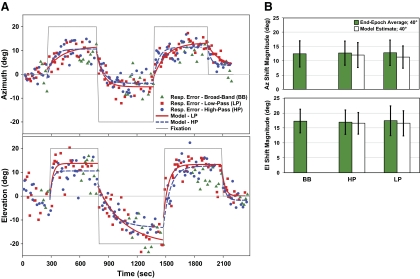Fig. 4.
Influence of eye position on sound localization across auditory spatial channels. A: example of sound localization to different interleaved auditory targets for a representative subject in response to gaze shifts in either Az (top) or El (center, up 20°, and down 20°; bottom). The changes in accuracy for low-pass (LP; red trace) and high-pass (HP; blue trace) targets are modeled as in Fig. 3 to examine the time constant (τ) and magnitude (a) of the change. Time constants are indistinguishable between target bands in both Az and El (P ≥ 0.06). Resp. Error, response error. B: overall shift magnitudes for broadband, HP, and LP targets in response to 40° gaze shifts (pooled for L and R) in Az or El, calculated as end-epoch averages (Δ accuracy) and model estimates (a; HP and LP only). Values prove comparable between target bands and calculation methods for both Az and El (P ≥ 0.72).

